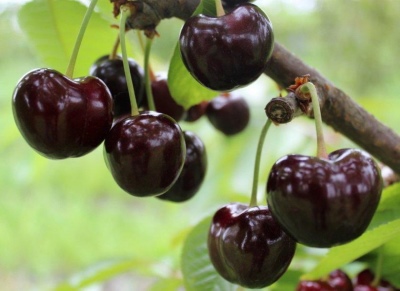
- Authors: Melitopol Institute of Irrigated Horticulture of Ukraine
- Appeared when crossing: Drogana yellow x Valery Chkalov
- Growth type: medium-sized
- Appointment: for all types of processing, for fresh consumption
- Yield: high
- Crown: spherical
- Sheet: with pointed tip and serrated edge
- Fruit size: large
- Fruit weight, g: 10-14,5
- Fruit size, mm: 28-30
Cherry Skazka is one of the best varieties that attracts gardeners with an excellent yield indicator and the ability to grow in the northern regions. Differs in strong immunity.
Description of the variety
A fairy tale is a tall tree that rises to a height of 3.5-4 meters. Specifications:
spherical or pyramidal crown;
rough leaves of medium size with jagged edges;
small white flowers.
Crown color varies from bright green to dark shades depending on the season.
Fruit characteristics
The variety forms spherical fruits. Main characteristics:
color - dark red;
weight - 10-14.5 g;
the stone is round, small;
the skin is dense.
The fruits are distinguished by good transportability, which makes it possible to transport over long distances.
Taste qualities
Tasters rate the dessert taste of Skazka berries by 4.5 points. The pulp of the fruit of the variety is tender, the bone is well separated from it.
Ripening and fruiting
Variety Skazka belongs to the group of early ripening plants. The first fruits are formed by mid-May, the duration of fruiting is a month and a half. If the spring is cold, then the dates are shifted by a week.

Yield
The average yield reaches 30 kg per tree. The first fruits appear in the fifth year, and during this period it is possible to collect up to 5 kg of fruits from the tree.
Growing regions
The variety is actively planted in the south of Ukraine and in Russia. The tree takes root well both in the southern regions and in the northern ones.
Growing and care
The yield of the variety directly depends on the choice of location, seedling, as well as on the approach to plant care. First you need to decide on a place for planting a tree.
Preference should be given to hills or plains with deep groundwater, where there is no risk of flooding.
The site must be well lit, without drafts.
It is not recommended to plant cherries in clay and sandy loam soils.
When the place is chosen, you can proceed to the selection of the seedling. Gardeners are advised to immediately discard specimens with defects. Such trees may not take root and die. Additionally, you should pay attention to the roots: they must be dry and healthy.
It is better to plant the Fairy Tale in the spring, when the snow has completely melted and the weather is warm. In the southern regions, landing in the autumn is possible. Landing scheme.
2 weeks before planting the culture, they dig a hole up to 80 cm deep and up to 90 cm in diameter. In the process, the land is divided into fertile and infertile.
A fertile mixture of soil and compost mixed in equal proportions is poured into the depth of the pit.
A peg is installed, sticking out 50 cm from the ground. He will act as a support for the future seedling.
Set the tree by gently spreading the roots. The trunk is tied to a peg for fixation.
Fall asleep and ram the remaining space in the holes, form a watering groove and pour in water.
After that, it remains to take care of timely care, which will help to achieve active plant growth and a bountiful harvest.
Watering. The first one is applied immediately after planting the seedlings into the ground in an amount of 10-15 liters of water. Then the plant is watered during the period of bud swelling, as well as 2 weeks before harvest. The last time water is introduced into the ground in the fall, before the onset of frost.
Top dressing. The following fertilizers are used: complex formulations - in mid-April, phosphorus-potassium supplements in June and organic matter before the cold weather.
Weeding and loosening. The soil must be saturated with oxygen. This will help to make timely removal of weeds, which take away nutrients from cherries, and loosening of the soil. The interval is determined by eye.
Pruning. Two types of pruning should be carried out: shaping crown and sanitary. From the name of the first one, you can guess that we are talking about the removal of branches that spoil the shape of the crown. The second pruning involves the elimination of withered and diseased branches, leaves.
Sweet cherry Skazka is an undemanding variety that can take root in almost any conditions and please the gardener with a bountiful harvest.




Disease and pest resistance
The variety is distinguished by strong immunity, but this does not mean that the cherries are not attacked by diseases and pests. To prevent the death of the plant, it is worth taking care of the preventive treatment of the roots, trunk, branches and leaves.

Requirements for soil and climatic conditions
The tale is resistant to low temperatures, therefore, does not require additional care when frost sets in. The tree easily withstands cold temperatures down to -25 degrees and gives a good harvest for the next season.
































































